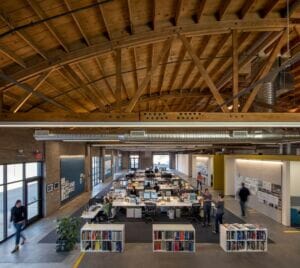Businesses are looking to save space as office trends change with the times
Recent and continuing changes in the market have created trends that can affect how companies buy and use space. Few companies actively pursue the traditional concept of the workplace any longer.
Part economics, part culture, and part marketing, companies now must consider much broader reaching concepts such as branding and work-life balance while trying to reduce their real estate costs.
Consolidation, whether locally or nationally, is bringing people together in less space while improving efficiency and creativity. Eric Rymshaw owner of Fury Design in the Greater Philadelphia area says, “Bringing everyone together into an owned building rather than using rental space outside of company headquarters is catching on fast, which means that companies get into a process of figuring out what kind of space their people really need to work in. Do they need an 8×10-foot work station, or is a 6×8-foot with the right storage and right counter space enough? How can they downsize? How can they get rid of the levels? The way businesses save space today is by efficient space planning, actually building in flexibility for change by not over stratifying the company.”
Mobility has affected the workplace by challenging what it means for space, human resources and project delivery. According to HOK senior vice president Pamela Light, there is a real push among clients to support remote work, to improve work/life balance for employees and reduce real estate costs. Not surprisingly, “The biggest reason is budget,” she notes. “Twenty percent of projects in the last 18 months have asked us for a 20 percent reduction in square footage.”
In these scenarios, most of the space savings, she says, are realized through the drop in dedicated workspace. Mobility not only pertains to remote workers, it happens within the workplace as well and supports a new level of collaboration.
Technology will enable the workplace to change when it is no longer place dependent. Work will become less dependent about being in a specific place at a specific time. Furniture and facilities will have to adapt to significant changes as technology breaks down this barrier between time and place.
As office trends continue and we move towards an “always-on and connected” world, everything changes and this will be especially true for buildings and the furniture that articulates these spaces. This integration of buildings, furniture and technology must take the high ground and provide more sophisticated solutions for housing, operating and maintaining the devices of a more nomadic and mobile workforce.
Collaboration is the new work model and activity-based planning supports collaboration. This paradigm shift is based on the work that people do, not the title that they hold. Rarely can a company afford to provide a large corner office for the top sales guy, if he’s out on the road three weeks a month and rarely in his office.
This new workplace provides spaces where employees who share common tasks, projects and goals can come together and work together in a space designated for team work. Supporting this move towards more collaboration is another shift in perception.
Employees don’t have to be at their desks with their heads down to be productive. They are much less tied to their desks, consequently a desk provides a place to check email, make a few calls, and provide limited, yet secure, storage.
Workplace demands have increased competitive pressures and the changing nature of work have led organizations to take a closer look at their workplace investment, according to “Creating Order out of Chaos.” Many are reducing the size of individual workspaces — in some cases, as a simple cost-cutting measure. Others are reallocating space to better support evolving ways of working. New ideas and developments help nurture an environment that enhances and improves the ability of the employee to work smarter.
There are fewer individual spaces and more people spaces being designed, ready to go with power and internet. A variety of spaces gives employees a choice as to how and where they want to work and support their work in many different ways. Areas such as a coffee bar or library space can offer comfortable, non-traditional types of work areas giving the employees a choice and a feeling of control in their work environment. The space people work in can have an impact on their output.
Branding brings another dimension to the power of workplace, office trends. The physical space used to conduct business is simply too visible and costly an asset to leave out of the brand-building equation. A company’s physical environment conveys a message, whether intended or not. Has the company created something that reinforces the brand identity or weakens it?
Customers bring certain expectations, if a company states that it’s efficient, affordable or innovative, the physical space must support those claims. It’s been a known fact that facilities can influence recruiting and retention, and companies now demand that the facilities define corporate culture and enhance the brand identity.
The workplace is an environment that is ever changing, new ideas and developments can create information overload. While cost tends to be a major factor in developing workplaces, employers can use office trends to increase the value of a company’s space beyond the dollars spent.
For more information about how to save some space in your workplace and cut costs due to these office trends changes, visit www.stgdesign.com.



